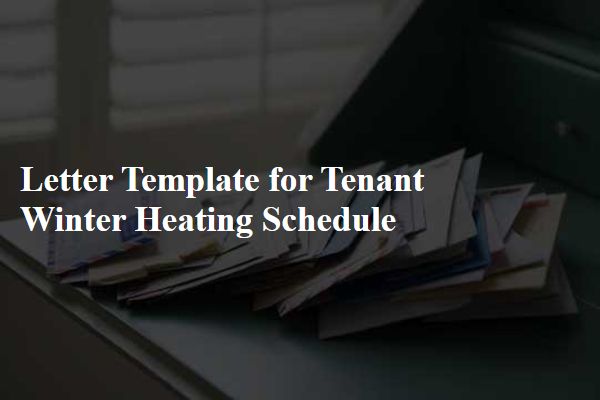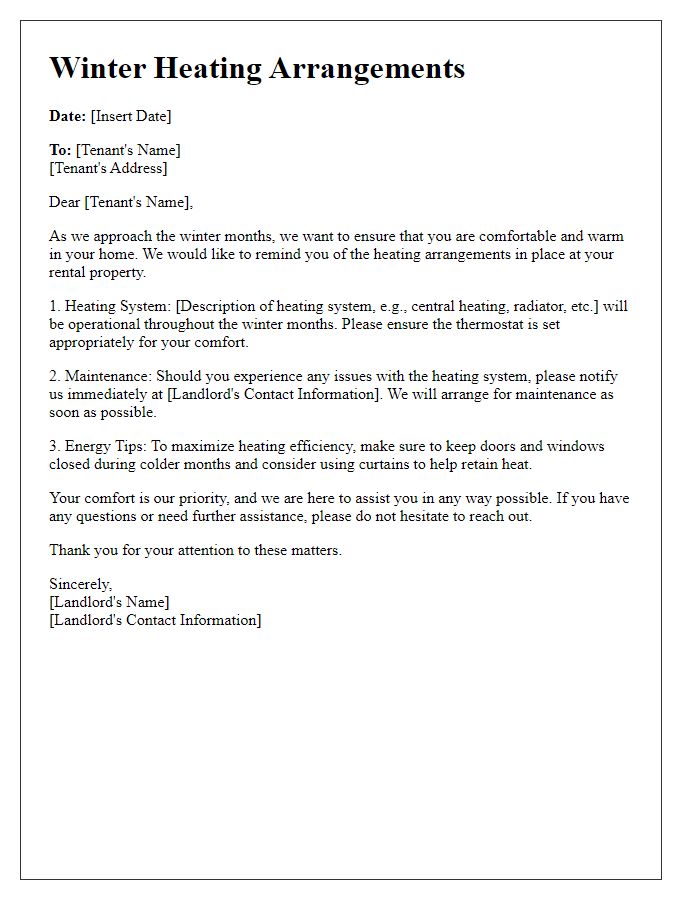As the chill of winter creeps in, it's essential for tenants to be informed about the heating schedule to ensure their comfort during the cold months. Understanding how and when the heating system operates can help create a cozy living environment. Our goal is to provide clear guidelines to help you navigate the heating schedule effectively. So, let's dive in and arm you with all the information you need to stay warm and toasty this winter!

Tenant Information
During the winter months, maintaining a comfortable indoor temperature is crucial for tenant welfare. Central heating systems, such as gas or electric furnaces, typically operate most efficiently when set to around 21 degrees Celsius (70 degrees Fahrenheit). Regular maintenance is essential; scheduled servicing of the heating equipment should occur annually, ideally in late autumn, before the cold weather sets in. Monitoring fuel levels, whether natural gas or heating oil, is necessary to ensure an uninterrupted supply throughout the winter. Tenants should be informed about the location of thermostats, usually situated in common areas or hallways, ensuring they have full control over the heating settings for their individual units. In case of extreme cold weather (below -5 degrees Celsius or 23 degrees Fahrenheit), additional heating adjustments may be necessary to prevent freezing pipes. It is essential for tenants to report any heating issues promptly to maintenance staff for timely resolution.
Heating Schedule Overview
The heating schedule overview provides essential details regarding the winter heating management for residential units. Each unit, including apartments and townhouses, will have designated heating times to ensure comfort during the cold months. The typical heating period spans from November 1st to March 31st, aligning with seasonal temperature drops often recorded in regions like the Northeast United States, where averages can dip below freezing. Scheduled heating hours will generally run from 6:00 AM to 10:00 AM, then resume from 4:00 PM to 11:00 PM to accommodate resident needs during peak usage times. Temperature settings will be maintained at a comfortable range of 68 to 72 degrees Fahrenheit, contributing to a healthy living environment while optimizing energy consumption. Tenants are encouraged to report any heating malfunctions immediately, ensuring timely resolutions before severe weather conditions impact living conditions.
Usage Guidelines
During winter months, proper heating practices are crucial to maintain an optimal indoor environment in residential properties. Recommended temperature setting ranges between 68 to 72 degrees Fahrenheit (20 to 22 degrees Celsius) for comfortable living conditions, while energy-saving measures can be implemented by lowering the thermostat during nighttime or when away. Key areas such as living rooms and bedrooms should receive priority heating, while less frequently used spaces like guest rooms may benefit from reduced temperatures. Regular maintenance checks of heating systems, such as furnaces and radiators, are essential, with suggested inspections at the beginning of the heating season each November. Additionally, tenants are encouraged to keep windows and doors sealed, avoiding cold drafts, ensuring energy efficiency. Implementing these guidelines ensures effective heating throughout the winter and reduces energy consumption, ultimately contributing to a sustainable living environment.
Energy Efficiency Tips
Efficient heating practices during winter months can significantly reduce energy costs and increase comfort within residential spaces. Homeowners in regions with harsh winters, such as the Midwest United States, often face skyrocketing utility bills due to inadequate heating management. Setting thermostats to 68 degrees Fahrenheit during the day and lowering it to 60 degrees Fahrenheit at night can save approximately 10% on heating bills. Utilizing programmable thermostats enhances energy savings by allowing for automatic adjustments based on daily routines. Ensuring that windows are properly sealed and insulated can prevent drafts and retain warmth, especially in older homes built before 1980 that may lack modern insulation standards. Regular maintenance of heating systems, such as changing filters, ensures optimal performance and efficiency, preventing breakdowns during the peak heating season. Engaging in these efficient practices allows tenants to enjoy a warm home while minimizing environmental impact and energy expenses.
Emergency Contact Information
During the winter months, tenants should be aware of the designated heating schedule to maintain comfort and safety within the leased properties, particularly in regions known for severe cold conditions, such as the Midwest or Northeastern United States. Emergency contact information is crucial for quick responses in case of heating failures or malfunctions. Tenants must retain contact details for property management or maintenance services, including 24/7 emergency lines typically leading to a qualified technician available promptly. Additionally, local utility companies often provide urgent contact numbers for gas or electric service disruptions, ensuring tenants receive immediate assistance to avoid hazardous conditions related to inadequate heating, such as potential pipe freezing or health risks from hypothermia.













Comments